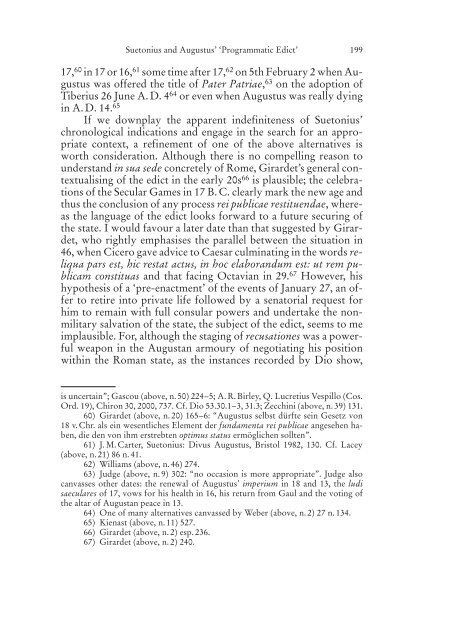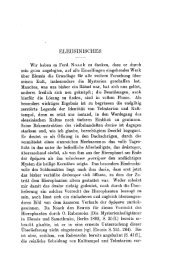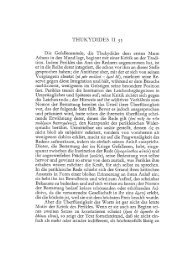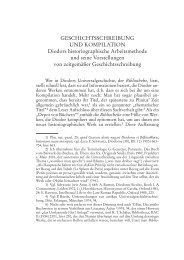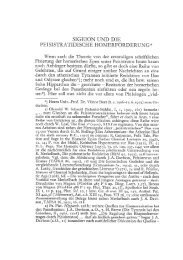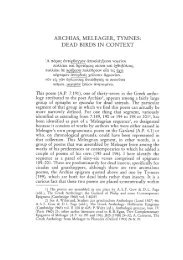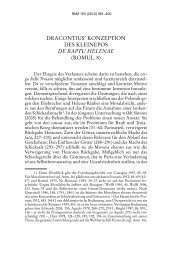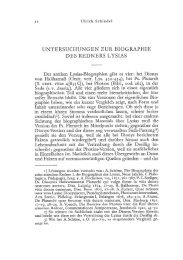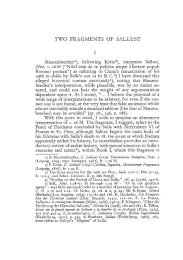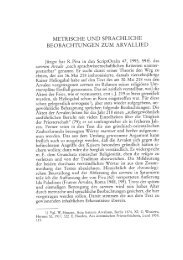VIRGILIO E STESICORO Una ricerca sulla Tabula Iliaca Capitolina *
VIRGILIO E STESICORO Una ricerca sulla Tabula Iliaca Capitolina *
VIRGILIO E STESICORO Una ricerca sulla Tabula Iliaca Capitolina *
Sie wollen auch ein ePaper? Erhöhen Sie die Reichweite Ihrer Titel.
YUMPU macht aus Druck-PDFs automatisch weboptimierte ePaper, die Google liebt.
Suetonius and Augustus’ ‘Programmatic Edict’<br />
17, 60 in 17 or 16, 61 some time after 17, 62 on 5th February 2 when Augustus<br />
was offered the title of Pater Patriae, 63 on the adoption of<br />
Tiberius 26 June A. D. 4 64 or even when Augustus was really dying<br />
in A. D. 14. 65<br />
If we downplay the apparent indefiniteness of Suetonius’<br />
chronological indications and engage in the search for an appropriate<br />
context, a refinement of one of the above alternatives is<br />
worth consideration. Although there is no compelling reason to<br />
understand in sua sede concretely of Rome, Girardet’s general contextualising<br />
of the edict in the early 20s 66 is plausible; the celebrations<br />
of the Secular Games in 17 B. C. clearly mark the new age and<br />
thus the conclusion of any process rei publicae restituendae, whereas<br />
the language of the edict looks forward to a future securing of<br />
the state. I would favour a later date than that suggested by Girardet,<br />
who rightly emphasises the parallel between the situation in<br />
46, when Cicero gave advice to Caesar culminating in the words reliqua<br />
pars est, hic restat actus, in hoc elaborandum est: ut rem publicam<br />
constituas and that facing Octavian in 29. 67 However, his<br />
hypothesis of a ‘pre-enactment’ of the events of January 27, an offer<br />
to retire into private life followed by a senatorial request for<br />
him to remain with full consular powers and undertake the nonmilitary<br />
salvation of the state, the subject of the edict, seems to me<br />
implausible. For, although the staging of recusationes was a powerful<br />
weapon in the Augustan armoury of negotiating his position<br />
within the Roman state, as the instances recorded by Dio show,<br />
is uncertain”; Gascou (above, n. 50) 224–5; A. R. Birley, Q. Lucretius Vespillo (Cos.<br />
Ord. 19), Chiron 30, 2000, 737. Cf. Dio 53.30.1–3, 31.3; Zecchini (above, n. 39) 131.<br />
60) Girardet (above, n. 20) 165–6: “Augustus selbst dürfte sein Gesetz von<br />
18 v. Chr. als ein wesentliches Element der fundamenta rei publicae angesehen haben,<br />
die den von ihm erstrebten optimus status ermöglichen sollten”.<br />
61) J. M. Carter, Suetonius: Divus Augustus, Bristol 1982, 130. Cf. Lacey<br />
(above, n. 21) 86 n. 41.<br />
62) Williams (above, n. 46) 274.<br />
63) Judge (above, n. 9) 302: “no occasion is more appropriate”. Judge also<br />
canvasses other dates: the renewal of Augustus’ imperium in 18 and 13, the ludi<br />
saeculares of 17, vows for his health in 16, his return from Gaul and the voting of<br />
the altar of Augustan peace in 13.<br />
64) One of many alternatives canvassed by Weber (above, n. 2) 27 n. 134.<br />
65) Kienast (above, n. 11) 527.<br />
66) Girardet (above, n. 2) esp. 236.<br />
67) Girardet (above, n. 2) 240.<br />
199


